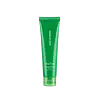What's inside
What's inside
 Key Ingredients
Key Ingredients

No key ingredients
 Benefits
Benefits

 Ingredients Side-by-side
Ingredients Side-by-side

Water
Skin ConditioningGlycerin
HumectantButylene Glycol
HumectantDipropylene Glycol
Humectant1,2-Hexanediol
Skin ConditioningTrehalose
HumectantHydrogenated Polydecene
EmollientDiglycerin
HumectantAcrylates/C10-30 Alkyl Acrylate Crosspolymer
Emulsion StabilisingAmmonium Acryloyldimethyltaurate/Vp Copolymer
Tromethamine
BufferingDipotassium Glycyrrhizate
HumectantXanthan Gum
EmulsifyingEthylhexylglycerin
Skin ConditioningPhormium Tenax Leaf Water
AntioxidantGlyceryl Acrylate/Acrylic Acid Copolymer
HumectantDisodium EDTA
Propanediol
SolventSecale Cereale Seed Extract
AbrasiveTriticum Vulgare Germ Extract
Skin ConditioningCentella Asiatica Extract
CleansingPolyglutamic Acid
Skin ConditioningWater, Glycerin, Butylene Glycol, Dipropylene Glycol, 1,2-Hexanediol, Trehalose, Hydrogenated Polydecene, Diglycerin, Acrylates/C10-30 Alkyl Acrylate Crosspolymer, Ammonium Acryloyldimethyltaurate/Vp Copolymer, Tromethamine, Dipotassium Glycyrrhizate, Xanthan Gum, Ethylhexylglycerin, Phormium Tenax Leaf Water, Glyceryl Acrylate/Acrylic Acid Copolymer, Disodium EDTA, Propanediol, Secale Cereale Seed Extract, Triticum Vulgare Germ Extract, Centella Asiatica Extract, Polyglutamic Acid
Water
Skin ConditioningGlycerin
HumectantButylene Glycol
HumectantCaprylyl Methicone
Skin ConditioningTrehalose
Humectant1,2-Hexanediol
Skin ConditioningHydrogenated Polydecene
EmollientDiphenylsiloxy Phenyl Trimethicone
Skin ConditioningHydroxyethyl Urea
HumectantAcrylates/C10-30 Alkyl Acrylate Crosspolymer
Emulsion StabilisingHydrogenated Lecithin
EmulsifyingBeta-Glucan
Skin ConditioningAmmonium Acryloyldimethyltaurate/Vp Copolymer
Glycoproteins
Skin ConditioningDimethicone/Phenyl Vinyl Dimethicone Crosspolymer
Tromethamine
BufferingGlyceryl Acrylate/Acrylic Acid Copolymer
HumectantTrisodium EDTA
Water, Glycerin, Butylene Glycol, Caprylyl Methicone, Trehalose, 1,2-Hexanediol, Hydrogenated Polydecene, Diphenylsiloxy Phenyl Trimethicone, Hydroxyethyl Urea, Acrylates/C10-30 Alkyl Acrylate Crosspolymer, Hydrogenated Lecithin, Beta-Glucan, Ammonium Acryloyldimethyltaurate/Vp Copolymer, Glycoproteins, Dimethicone/Phenyl Vinyl Dimethicone Crosspolymer, Tromethamine, Glyceryl Acrylate/Acrylic Acid Copolymer, Trisodium EDTA
 Reviews
Reviews

Ingredients Explained
These ingredients are found in both products.
Ingredients higher up in an ingredient list are typically present in a larger amount.
1,2-Hexanediol is a synthetic liquid and another multi-functional powerhouse.
It is a:
- Humectant, drawing moisture into the skin
- Emollient, helping to soften skin
- Solvent, dispersing and stabilizing formulas
- Preservative booster, enhancing the antimicrobial activity of other preservatives
Acrylates/C10-30 Alkyl Acrylate Crosspolymer is a synthetic polymer. It is used to thicken and improve the texture of products. Due to its properties, it can prevent water and oil ingredients from separating.
Ammonium Acryloyldimethyltaurate/Vp Copolymer (let's call it AAVC for short) is a synthetically created polymer. It's used as a film-forming agent and used to thicken the consistency of products.
AAVC is able to increase the consistency and viscosity of products due to its large molecule size. It also prevents ingredients from separating.
Butylene Glycol (or BG) is used within cosmetic products for a few different reasons:
Overall, Butylene Glycol is a safe and well-rounded ingredient that works well with other ingredients.
Though this ingredient works well with most skin types, some people with sensitive skin may experience a reaction such as allergic rashes, closed comedones, or itchiness.
Learn more about Butylene GlycolGlycerin is already naturally found in your skin. It helps moisturize and protect your skin.
A study from 2016 found glycerin to be more effective as a humectant than AHAs and hyaluronic acid.
As a humectant, it helps the skin stay hydrated by pulling moisture to your skin. The low molecular weight of glycerin allows it to pull moisture into the deeper layers of your skin.
Hydrated skin improves your skin barrier; Your skin barrier helps protect against irritants and bacteria.
Glycerin has also been found to have antimicrobial and antiviral properties. Due to these properties, glycerin is often used in wound and burn treatments.
In cosmetics, glycerin is usually derived from plants such as soybean or palm. However, it can also be sourced from animals, such as tallow or animal fat.
This ingredient is organic, colorless, odorless, and non-toxic.
Glycerin is the name for this ingredient in American English. British English uses Glycerol/Glycerine.
Learn more about GlycerinGlyceryl Acrylate/Acrylic Acid Copolymer is made up of glycerin and polyacrylic acid. It helps hydrate your skin as a humectant.
This ingredient forms a hydrogel that delivers moisturizing, water-based ingredients to the skin. It is also used to thicken a product and to give it a smooth texture.
Acrylic acid itself is toxic, but the polymer form (this ingredient) is too large to penetrate skin, making it non-toxic.
Learn more about Glyceryl Acrylate/Acrylic Acid CopolymerHydrogenated Polydecene is an emollient. It creates a non-occlusive film on the skin that offers extra protection for your skin barrier.
The texture of Hydrogenated Polydecene ranges from light and silky to rich.
Hydrogenated Polydecene is the end compound of controlled hydrogenation of Polydecene.
Learn more about Hydrogenated PolydeceneTrehalose is a disaccharide made of two glucose molecules (glucose is sugar!). Trehalose is used to help moisturize skin. It also has antioxidant properties.
As a humectant, trehalose helps draw moisture from the air to your skin. This helps keep your skin hydrated.
Due to its antioxidant properties, trehalose may help with signs of aging. Antioxidants help fight free-radical molecules, unstable molecules that may damage your skin.
In medicine, trehalose and hyaluronic acid are used to help treat dry eyes.
Some animals, plants, and bacteria create trehalose as a source of energy to survive freeze or lack of water.
Learn more about TrehaloseTromethamine helps balance the pH and improve the texture of a product. It is synthetically created.
As an emulsifier, Tromethamine prevents oil and water ingredients from separating. This helps stabilize the product and elongate a product's shelf life. Tromethamine also makes a product thicker.
Tromethamine helps balance the pH level of a product. Normal pH level of skin is slightly acidic (~4.75-5.5). The acidity of our skin is maintained by our glands and skin biome. Being slightly acidic allows our skin to create an "acid mantle". This acid mantle is a thin barrier that protects our skin from bacteria and contaminants.
Oral Tromethanmine is an anti-inflammatory drug but plays the role of masking, adding fragrance, and/or balancing pH in skincare.
1,3-Propanediol, 2-amino-2-(hydroxymethyl)-
Learn more about TromethamineWater. It's the most common cosmetic ingredient of all. You'll usually see it at the top of ingredient lists, meaning that it makes up the largest part of the product.
So why is it so popular? Water most often acts as a solvent - this means that it helps dissolve other ingredients into the formulation.
You'll also recognize water as that liquid we all need to stay alive. If you see this, drink a glass of water. Stay hydrated!
Learn more about Water